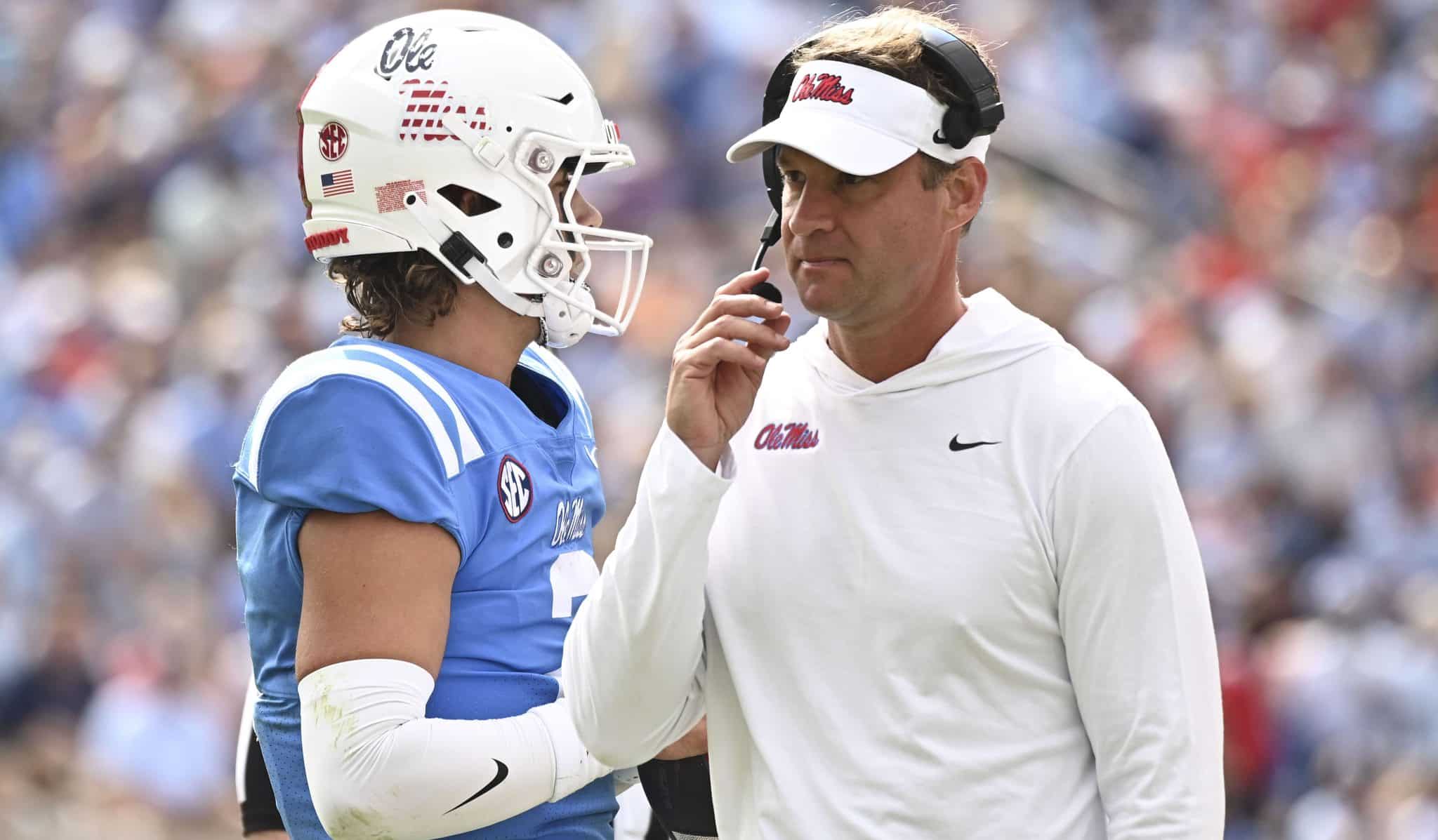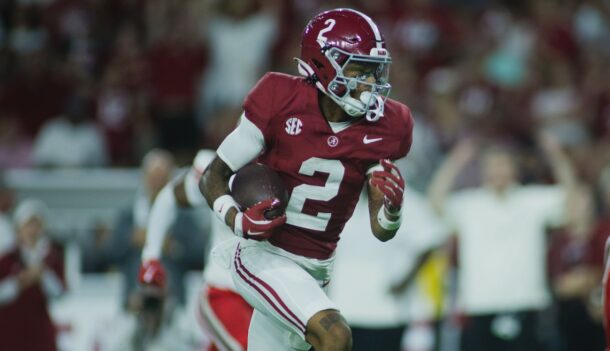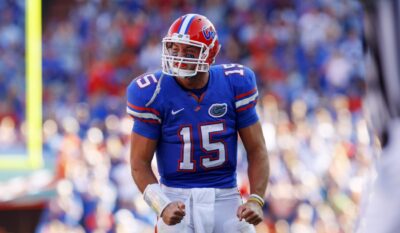
First and 10: How Lane Kiffin became college football’s Portal King
By Matt Hayes
Published:
1. I don’t want to get on a soapbox, but …
The tweets, the one-liners, the self-proclaimed Portal King.
It’s not a schtick, and he’s not the funny man who’s around to win a few games a hit on a few jokes. It’s out of necessity.
In the rapidly evolving unknown of college football roster building, this is how Lane Kiffin is making it work.
“My job is to put together the best roster every year,” Kiffin said.
So yeah, the Portal King is who he is because that’s what he has been forced into. If you’re not Georgia or Alabama or Ohio State and can churn annually through elite recruiting classes, you better find a unique way to build your roster.
If you’re not stacking blue-chip recruits on top of each other and can plug and play season after season, you must embrace the sticky tentacles of unintended consequences with the transfer portal and free player movement — the foundation of the changing face of college football over the past 2 years.
It’s not only the unknown of what you’re getting, it’s the instability of keeping what you have (more on that later). It’s recruiting 2 pools of player talent — high school, transfer portal — while developing your roster and massaging egos on the roster so it doesn’t leak into the transfer portal.
It’s having a backup plan for the original backup plan, and never forgetting that the No. 1 option within those plans is 1 strong NIL offer from walking away.
Portal King? Kiffin is head coach, general manager and his own personnel department every single day.
“It’s really like the NFL, where it’s turned into a professional sport as you look into free agency, or losing free agency, or what did you get in return,” Kiffin said earlier this month at his national signing day press conference. “No one is going to keep all of their players. It’s just too easy for kids to leave when they don’t like something.”
So how do you combat that, you ask? You use that NFL philosophy and shore up the most important position on the field with the only true guardrail set in place: a potential lost season of eligibility.
What looked so strange from the outside this offseason is perfectly explainable. Ole Miss added former Oklahoma State starting quarterback Spencer Sanders and former LSU blue-chip QB recruit Walker Howard to the roster, despite having one of the best young quarterbacks in the SEC in Jaxson Dart.
Understand this: Kiffin knows he can’t win in the SEC, can’t get to where he wants to be (playing in the SEC Championship Game and/or the Playoff), without high-level play from his quarterback. The last thing he needs at the quarterback position is turnover.
Adding Sanders and Howard wasn’t made with an eye on just this season. They were made for the near future, too.
It would be coaching malpractice if Kiffin — or any coach — didn’t have a legitimate backup quarterback (or 2) given the instability of roster building in the age of the transfer portal.
How do you get that stability? Ladies and gentlemen, I give you the unintended guardrail.
Once a player transfers and uses his 1 free pass, he can’t transfer again without sitting out a season. Unless, that is, he transfers as a graduate.
Exhibit A: Howard. He signed last year with LSU, and competed with Jayden Daniels and Garrett Nussmeier for the starting job. He left after the 2022 season and transferred to Ole Miss.
He has used his 1 free transfer, and now Ole Miss has him “under contract” — for lack of a better way of saying it in this NFL-type free agency — for at least the next 2-3 years, or unless he graduates early.
Sanders, meanwhile, played 4 seasons at Oklahoma State and had a 5th season available because of the COVID season of 2020. There was absolutely zero risk in bringing in Sanders, who has 85 career TDs (18 rush), to compete for the starting job.
If he wins the job, he’s performing at a higher level than the other 2 quarterbacks. If he doesn’t, he’s a strong veteran to have in case something goes wrong (see: Kiffin’s idea of structuring the position like an NFL roster), and Kiffin has Howard primed to take over in 2024 should Dart have a big season and leave for the NFL.
If Howard beats out both players, you have a quarterback who has played so well, he beat out an incumbent starter and another quarterback who started 4 seasons at a Power 5 school. And Dart, who transferred to Ole Miss last year from USC (and doesn’t have a free transfer remaining), likely isn’t leaving and risking sitting out a season.
Those mental gymnastics play out for every position on the roster, and all must be taken into account when deciding whom to add from the portal.
“(Players) being paid is awesome,” Kiffin said. “We just don’t have a system in place around it, with proper windows and contracts, with them being employees.”
So you have to game the system — to keep players happy, and keep the program moving forward.
2. The high school question
If Kiffin signs an elite high school quarterback (or any player), he could lose him after 1 season because he didn’t play, didn’t like how he was being coached — or any number of reasons.
He leaves, and there’s a hole in the roster.
That reality hit Kiffin this offseason when RB Quinshon Judkins — the best player on his roster and one of the best in college football — became the most sought non-QB this offseason. He not only had a free transfer available, but any team who could pry him from Ole Miss with a fat NIL deal could’ve locked him in for a minimum of 2 seasons.
These are the times, Kiffin says, when you have to trust your judgment and the new parameters set because of the instability of the new system. When recruiting high schoolers, it’s no longer just about game tape.
It’s where is he from, and what’s his personality? Is he more likely to transfer if he doesn’t get his way — or more problematic, if he plays well and suddenly has the heavyweights of college football throwing NIL cash at him.
Judkins led the SEC in rushing (1,567 yards) and scored 16 TDs, and had the second-best season in the history of the SEC for freshmen rushing yards (Herschel Walker had 1,616 yards in 1980).
Yet he stayed at Ole Miss, despite the push from schools with loaded NIL contracts.
“Out there you think it’s recruiting your kids once they go in the portal. No it’s not,” Kiffin said. “You’re recruiting your kids not to go in the portal because they’re being recruited, especially the significant, young players. The value of a young player that you can come take, like Quinshon, is more valuable than the great high school player because he can’t leave again.”
3. The Portal King, The Epilogue
It’s not over yet. We’ve had 2 high school signing days and the end of the winter portal window, and there’s 1 more chance to procure players for 2023.
The spring portal season opens May 1 for 15 days. That means any player who enters the portal within those 15 days, will be eligible to play in 2023 if they haven’t already used their free transfer or are a graduate transfer.
They don’t have to sign within the 15-day window, they just have to be in the portal and sign before the last day to start classes in the fall. One more opportunity for coaches and programs to improve for 2023 — and potentially sign players that are “under contract” for at least the next 2 seasons.
One more opportunity to secure some semblance of roster building.
Ole Miss could use an edge rusher, and an interior defensive lineman, as well as cover corners. New defensive coordinator Pete Golding’s defenses are based on pressure and coverage, forcing offenses to adjust to their movement.
But the reality is, Ole Miss likely will lose players after spring practice, too. It’s a fluid, turnover-fueled business with minimal stability and security.
The only constant is the need to win.
“There’s really no way to map out a plan any more of exactly what you are going to do because there are just too many variables,” Kiffin said.
4. Florida’s NIL change
A significant bill was signed into law last week in the state of Florida, one that will forever change the way FBS schools in the state recruit high school and transfer portal players.
And it has nothing to do with the Jaden Rashada $13 million NIL “contract” drama at Florida.
Broken down to its simplest meaning: Schools can now directly facilitate NIL deals — whereas before, they could not.
That means, more than anything, the days of “advisors” and “middle men” dictating salary structure to unwitting collectives without direct involvement from the schools are over.
While it looks like the Florida legislature took all of a month to make a change to a critical law — in the wake of the Rashada fiasco — this has been an ongoing process within the legislature for more than a year. The initial law, with good intentions to protect both player and university, had left the state’s FBS schools falling behind programs in other states that had no guardrails.
It also has added more pressure to the state’s Power 5 coaches. If you can’t recruit Top 10 classes in 1 of the 3 most fertile states for high school football, the window of job security will quickly close.
Florida coach Billy Napier’s first 2 classes were ranked No. 18 and No. 14 in the 247Sports composite. Miami coach Mario Cristobal’s first 2 classes were ranked No. 16 and No.7.
FSU coach Mike Norvell has yet to land a Top 10 class in 4 years: 22nd, 23rd, 20th, 19th.
Under the new state of Florida rule, a $13 million ask from a player (see: an “advisor”) never gets that far. Coaches know the budgets, know what they’ll pay for specific players (high school and portal), and can sit down, face to face, and talk money — with no misinterpretation.
A majority of the states with NIL laws have this structure. When Florida passed its initial law — one of the first along with the state of California — it instituted guardrails with the goal of insulating universities and protecting them from becoming mini-NFL franchises.
Now the guardrails are off, and now Florida, FSU, Miami and UCF — the state’s 4 Power 5 schools — can facilitate deals.
5. The Weekly 5
Tennessee’s 2023 national championship odds and 5 things the Vols need to reach the Playoff:
1. QB Joe Milton makes a Hendon Hooker-level jump in his 1st season as starter — and avoids a quarterback controversy with 5-star freshman Nico Iamaleava.
2. WR Bru McCoy finally grows into his elite 5-star talent (there were glimpses in 2022), and gives Vols a true No. 1 receiver.
3. Critical additions from the portal — LB Keenan Pili and CB Gabe Jeudy-Lally (BYU), DT Omarr Norman-Lott (Arizona State) — strengthen the defense up the middle against the run and outside in pass coverage.
4. At least 2 of the 5 freshman defensive line recruits — top 100 players DT Daevin Hobbs and edge Caleb Herring — provide impact along the defensive front rotation and help the Vols improve on 31 sacks from 2022.
5. DT Omari Thomas, an immense talent, becomes a consistent disrupter in the middle of the Tennessee defense and has an All-American season in his last year in Knoxville.
6. Your tape is your resume
An NFL scout analyzes a draft-eligible SEC player. This week: Texas A&M S Antonio Johnson.
“Just a freakish athlete with a great frame. In a couple of years, he’s going to be a 220-pound grown man, and potentially one of the best safeties in our league. I have zero doubt of that. He’s a sub-4.5 guy who can run, and he has great instincts. He’s long and he can elevate on those 50-50 balls. A willing and tough and reliable tackler, and a guy who can mirror in coverage. Those guys don’t come around often.”
7. Powered Up
This week’s Power Poll, and 1 big thing: most important coaching staff addition.
1. Georgia: OC Mike Bobo. Had a fantastic track record at Georgia. Why would it change now with better players?
2. Alabama: OC Tommy Rees. A strange hire, on fit alone. But Nick Saban hasn’t made a mistake with OC hires, why now?
3. Tennessee: OC Joey Halzle. Has been with Vols coach Josh Heupel since his time at UCF, and helped develop Hendon Hooker. A natural promotion from QBs coach.
4. LSU: No additions — which is significant considering 3 assistants (OC Mike Denbrock, DC Matt House, WR/Passing game coordinator Cortez Hankton) were pursued by NFL and CFB teams.
5. Texas A&M: OC/QBs Bob Petrino. If the egos of coach Jimbo Fisher and Petrino don’t clash, it’s the best hire of the offseason — one that could lead to Texas A&M rejoining the nation’s elite.
6. Ole Miss: DC Pete Golding. Kiffin was able to keep OC Charlie Weis Jr. and added Golding from Alabama. Vastly underrated at Alabama, Golding will be reenergized under Kiffin.
7. Kentucky: OC/QBs Liam Coen. After a year in the NFL, Coen returns to the Commonwealth and gets an elite quarterback: NC State transfer Devin Leary.
8. South Carolina: OC/QBs Dowell Loggains. Has 16 years of NFL experience as an OC or QBs coach, a perfect fit for a passing game that found itself late in 2022.
9. Arkansas: OC/QBs Dan Enos. A perfect fit for the staff, Enos loved his time in Fayetteville when he coached under Bret Bielema and walks into a good situation with star QB KJ Jefferson.
10. Mississippi State: DC Matt Brock. Arrived at MSU in 2020 with Mike Leach, and made an immediate impression on DC (and now head coach) Zach Arnett, who has given Brock control of the defense.
11. Florida: Analyst Eric Kiesau. A former OC at numerous Power 5 and Group of 5 schools, Kiesau is a longtime quarterbacks coach who will work with quarterbacks and the passing game.
12. Missouri: OC Kirby Moore. Coach Eli Drinkwitz, a highly regarded play-caller as an assistant at App State, has not only given up control of the offense to Moore, he has given up play-calling duties, too.
13. Auburn: DC Ron Roberts. Spent the past 3 seasons as DC of talented and fast Baylor defenses, and learned under one of the best defensive minds in the game (Baylor coach Dave Aranda).
14. Vanderbilt: RBs Jayden Everett. The first Power 5 job for Everett, who has built his reputation as a strong running backs coach and recruiter.
8. Ask and you shall receive
Matt: Coach Billy Napier says he’s going to continue to look in the portal for players. Does that include quarterback, and if so, who’s available? — Tony Dudley, Tampa.
Tony:
Unless something strange or unique happens in spring practice, Florida more than likely is set at quarterback for 2023. That means Wisconsin transfer Graham Mertz, Jack Miller or Max Brown.
There are, however, a couple of potential strange or unique possibilities — for Florida and Auburn, the 2 SEC schools that need quarterbacks.
At the top of the list is the Ohio State quarterback job, where Kyle McCord (the favorite) will battle Devin Brown. Both are former top 50 players, and McCord was CJ Stroud’s backup the past 2 seasons, starting a game in 2021 when Stroud was injured. If Brown, a redshirt freshman, doesn’t win the job, does he leave?
Ethan Garbers at UCLA is another potential candidate. He was Dorian Thompson-Robinson’s backup the past 2 seasons, and will battle Kent State transfer Collin Schlee in spring practice. In the fall, 5-star recruit (and top 5 overall) Dante Moore enters the competition.
Other possibilities: Casey Thompson, who is competing with Georgia Tech transfer Jeff Sims at Nebraska, and Evan Prater, who is battling Ben Bryant at Cincinnati.
9. Numbers
24. Georgia had 15 players selected in the 2022 NFL Draft and should have another 9 selected in April — for a total of 24 over the back-to-back national championship seasons.
In the 2022 draft, Georgia had 5 first-round picks. In the 2023 draft, there could be as many as 5 again: DT Jalen Carter, CB Kelee Ringo, TE Darnell Washington, OT Broderick Jones and LB Nolan Smith.
RB Kenny McIntosh, QB Stetson Bennett, S Christopher Smith and LB Robert Beal Jr. will also likely be selected in the 2023 draft.
10. Quote to note
Arkansas coach Sam Pittman on roster management and the spring portal: “There’s 85 scholarships, and we’re at 76. Once you get to 76, if you look at it as an NFL pattern, they’re at 53 and they seem to be able to get pretty good players out there. So I think right now, (signing players) would be the best players available.”
Matt Hayes is a national college football writer for Saturday Down South. You can hear him daily from 12-3 p.m. on 1010XL in Jacksonville. Follow on Twitter @MattHayesCFB







